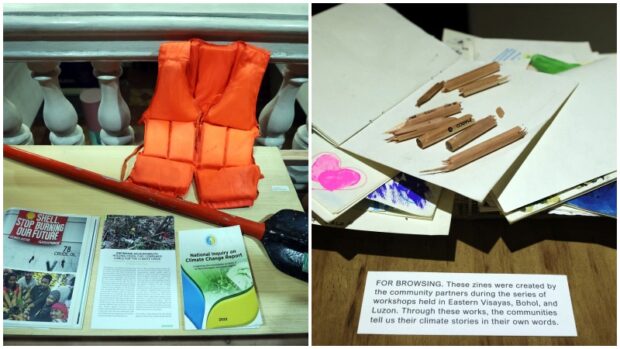Exhibit features ‘range of stories’ in 2013 supertyphoon’s wake

‘OBJECTS OF MEMORY’ | The People’s Museum of Climate Justice, an exhibit recently shown in Tacloban City amid the 10th-year commemoration of Supertyphoon “Yolanda” this year, was set up at Malate Catholic School in Manila this month and is available for viewing until Nov. 30. The museum features various objects and artworks which serve to recount stories of residents affected by the storm in 2013. —MARIANNE BERMUDEZ
MANILA, Philippines — In the middle of a supertyphoon when your home is almost sinking, what else will you save apart from your loved ones?
For most survivors of Yolanda (international name: Haiyan), it was their simple yet precious belongings — from clothes and blankets to kitchen implements and other household items.
The devastation left by the storm 10 years ago this month is perhaps the biggest case here for the pursuit of climate justice, which the United Nations Development Programme (UNDP) defines as “putting equity and human rights at the core of decision-making and action on climate change.”
But that term has been rendered too complex and abstract in the language of technocrats. In an attempt to humanize the concept of climate justice, Greenpeace Philippines has organized an exhibit featuring various mementos collected from Tacloban — Yolanda’s ground zero — and other climate-impacted communities in the country, from Metro Manila to Bohol.
Titled “People’s Museum of Climate Justice,” the exhibit was featured in Tacloban before it was transferred to Malate Catholic Church in Manila. Visitors can see this show until Nov. 30.
Centerpiece
The museum features “a range of stories meant to ground the whole discussion” on the impact of climate change, curator Bianca Ma-alat said in an interview with the Inquirer.
Its centerpiece is an assemblage of letters from Yolanda survivors, as they vividly recount, in this traditional form of communication, their experience with the supertyphoon.
Some of the letters are quite a difficult read emotionally, said Ma-alat, citing for example a letter from a father apologizing to his children for not being able to save their mother.
“To all my wife’s children, …I’m sorry. I did not expect she would be swept away by two waves coming one after another. I love your Mama very much,” the letter read.
Another featured object is a teddy bear belonging to Shane Carmaceta of Quinapondan town, Eastern Samar.
The 22-year-old student of Leyte Normal University was only 12 when Yolanda swept through Eastern Visayas. She told museum organizers that the teddy bear symbolizes her stolen childhood.
“Imagine, that was 10 years ago. She was 12 years old and she’s in college now. Imagine being a child and having that as one of your key experiences as you’re growing up,” Ma-alat said.
‘Strange experience’
Also noteworthy is a list prepared by writer, artist, and development worker Mark Anthony Simbajon of everyone who perished in his family.
“They have this uncanny tradition of listing down the names of the people in their family who passed away. But in the aftermath of Yolanda, even the missing were included in their lists,” Ma-alat said.
Simbajon, 29, also had the “strange experience,” as Ma-alat described it, of finding his name in a memorial for Yolanda victims. He went missing for about three months after the storm when he was stranded and no one could find him.
“A museum is a bastion of memory—a collection of tangible and intangible artifacts that carry narratives and experiences of people, put forward to be immortalized,” he said of the show.
“For us coming from communities at the receiving end of the impacts of the climate crisis, this is our physical concretization of strength—strength that defines our truth, truth that refuses to be just sidelines of history,” he added.
Causeway project
Before putting up the museum, Greenpeace held a series of workshops among the communities in Eastern Visayas, joined by Yolanda survivors from Central Visayas and nongovernmental organizations in Luzon.
The participants were asked to draw maps on cartolinas illustrating their history, livelihood and environment. These artworks were then “weaved” into organza fabrics whose silk texture symbolized the transparency of their situation, Ma-alat said.
One of the maps features a causeway project that its proponents said would cut travel time to Daniel Z. Romualdez Airport in Tacloban City—but which residents near Cancabato Bay opposed because the project could affect its biodiversity.
The city council on May 25 ordered a halt to the P4-billion project after the Department of Public Works and Highways (DPWH) failed to present an environmental study on Cancabato Bay, which is declared by an ordinance as a marine protected area.
But in August, the city council approved the causeway project, according to the DPWH. The agency also said there were no environmental problems regarding the project.
‘Human focus’
Ma-alat cited one notable memento in the exhibit — an “ayuda” bag (or a bag containing relief goods) identified as coming from the “City of Manila” and donated all the way to a calamity survivor in Cagayan province.
“Imagine you’re from Cagayan, then you receive this bag so when he was talking about this, he was questioning why the ayuda needs to be politicized,” she said.
Through its Manila exhibit, Greenpeace said the People’s Museum of Climate Justice “aims to bring these abstract statistics [of climate justice] into human focus.”
Greenpeace campaigner Eunille Santos said the People’s Museum is “a platform that brings the realities of climate change experienced by the most marginalized communities around the country to the fore.”
“Each object of memory on display is not just a remnant of climate disasters. Behind them are stories that show the strength of the Filipinos,” he said.
Admission is free, but guests are encouraged to register online by clicking this link: RW Open Boat & People’s Museum of Climate Justice Tour.